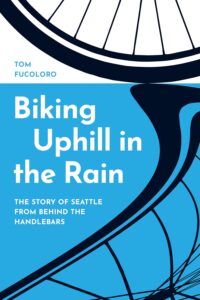A few weeks ago, I went to the Bainbridge Island Museum of Art to hear Tom Fucoloro speak about his delightfully named book Biking Uphill in the Rain: The Story of Seattle from Behind the Handlebars. Tom also writes the Seattle Bike Blog. His talk was sponsored by Squeaky Wheels, with Bainbridge GreenWays and the Cascade Bicycle Club, among the co-sponsors.
Tom was funny, informed, and insightful about Seattle’s bike history. My takeaway from Tom’s talk? If you are trying to shift from a car culture to a culture of active transportation, you are in for a LOT of opposition. And… if you are tireless in your advocacy, eventually you can win.
In his historical review, Tom noted that Seattle had a thriving bike culture at the end of the nineteenth century, with many good bike paths. Then, as cars took over, that culture almost completely died. Few people biked. The invention of the multi-geared bike in the 50s helped. Then in 1968 there was a turning point. On April 28, Seattle held its first car-free Bike Sunday. The Parks Department was skeptical anyone would show up and planned for a few hundred. In fact, 5,000 cyclists came.
As the cyclists saw the power of their numbers, they organized. They imagined a car-free trail on a little-used railroad track, a track once promoted by Thomas Burke and Daniel Gilman. Their campaign kicked into high gear in 1971. The Burke-Gilman Trail has now become enormously popular. But at the time, it faced plenty of resistance. The arguments are familiar today – no one will use it, people won’t get out of their cars, it costs too much, local landowners need to protect their privacy, the trail will bring crime to the neighborhood, etc. etc.
Tom reported that the cyclist community was united and persistent in advocating for the Trail. That paid off and a big section of the Burke-Gilman Trail opened in 1978. Local residents turned out to love it. The city pursued more car-free trails. But for the roads, the city’s action was simply to post signs saying the road was a bike route, without making any special lane–a move that worked for confident cyclists, but not for everyone else.
Gradually advocacy for special bike lanes protected from traffic grew. Many people wanted paths that their 8-year-old could use. Seattle Neighborhood GreenWays formed and joined with the Cascade Bicycle Club to advocate for safe streets and bicycling as a mainstream priority. As the 2010s unfolded, those safe, protected pathways began to be built.
At Tom’s talk, I asked what he’s learned about how to get more biking and walking paths that were safe enough for kids. His answer? Just keep building them. All kinds of people will start using them and discover their enormous benefits. Gradually you build up a big constituency for safe, biking and walking paths protected from traffic. And that gives you the leverage to build even more.
So, Tom taught me: “Just keep at it!” Bainbridge GreenWays and Squeaky Wheels will do just that. And we hope you will too.

